Bing Zhou
Zhengzhou University
Ponimator: Unfolding Interactive Pose for Versatile Human-human Interaction Animation
Oct 16, 2025Abstract:Close-proximity human-human interactive poses convey rich contextual information about interaction dynamics. Given such poses, humans can intuitively infer the context and anticipate possible past and future dynamics, drawing on strong priors of human behavior. Inspired by this observation, we propose Ponimator, a simple framework anchored on proximal interactive poses for versatile interaction animation. Our training data consists of close-contact two-person poses and their surrounding temporal context from motion-capture interaction datasets. Leveraging interactive pose priors, Ponimator employs two conditional diffusion models: (1) a pose animator that uses the temporal prior to generate dynamic motion sequences from interactive poses, and (2) a pose generator that applies the spatial prior to synthesize interactive poses from a single pose, text, or both when interactive poses are unavailable. Collectively, Ponimator supports diverse tasks, including image-based interaction animation, reaction animation, and text-to-interaction synthesis, facilitating the transfer of interaction knowledge from high-quality mocap data to open-world scenarios. Empirical experiments across diverse datasets and applications demonstrate the universality of the pose prior and the effectiveness and robustness of our framework.
Two Sides of the Same Optimization Coin: Model Degradation and Representation Collapse in Graph Foundation Models
Sep 11, 2025Abstract:Graph foundation models, inspired by the success of LLMs, are designed to learn the optimal embedding from multi-domain TAGs for the downstream cross-task generalization capability. During our investigation, graph VQ-MAE stands out among the increasingly diverse landscape of GFM architectures. This is attributed to its ability to jointly encode topology and textual attributes from multiple domains into discrete embedding spaces with clear semantic boundaries. Despite its potential, domain generalization conflicts cause imperceptible pitfalls. In this paper, we instantiate two of them, and they are just like two sides of the same GFM optimization coin - Side 1 Model Degradation: The encoder and codebook fail to capture the diversity of inputs; Side 2 Representation Collapse: The hidden embedding and codebook vector fail to preserve semantic separability due to constraints from narrow representation subspaces. These two pitfalls (sides) collectively impair the decoder and generate the low-quality reconstructed supervision, causing the GFM optimization dilemma during pre-training (coin). Through empirical investigation, we attribute the above challenges to Information Bottleneck and Regularization Deficit. To address them, we propose MoT (Mixture-of-Tinkers) - (1) Information Tinker for Two Pitfalls, which utilizes an edge-wise semantic fusion strategy and a mixture-of-codebooks with domain-aware routing to improve information capacity. (2) Regularization Tinker for Optimization Coin, which utilizes two additional regularizations to further improve gradient supervision in our proposed Information Tinker. Notably, as a flexible architecture, MoT adheres to the scaling laws of GFM, offering a controllable model scale. Compared to SOTA baselines, experiments on 22 datasets across 6 domains demonstrate that MoT achieves significant improvements in supervised, few-shot, and zero-shot scenarios.
HIAL: A New Paradigm for Hypergraph Active Learning via Influence Maximization
Jul 28, 2025Abstract:In recent years, Hypergraph Neural Networks (HNNs) have demonstrated immense potential in handling complex systems with high-order interactions. However, acquiring large-scale, high-quality labeled data for these models is costly, making Active Learning (AL) a critical technique. Existing Graph Active Learning (GAL) methods, when applied to hypergraphs, often rely on techniques like "clique expansion," which destroys the high-order structural information crucial to a hypergraph's success, thereby leading to suboptimal performance. To address this challenge, we introduce HIAL (Hypergraph Active Learning), a native active learning framework designed specifically for hypergraphs. We innovatively reformulate the Hypergraph Active Learning (HAL) problem as an Influence Maximization task. The core of HIAL is a dual-perspective influence function that, based on our novel "High-Order Interaction-Aware (HOI-Aware)" propagation mechanism, synergistically evaluates a node's feature-space coverage (via Magnitude of Influence, MoI) and its topological influence (via Expected Diffusion Value, EDV). We prove that this objective function is monotone and submodular, thus enabling the use of an efficient greedy algorithm with a formal (1-1/e) approximation guarantee. Extensive experiments on seven public datasets demonstrate that HIAL significantly outperforms state-of-the-art baselines in terms of performance, efficiency, generality, and robustness, establishing an efficient and powerful new paradigm for active learning on hypergraphs.
Simultaneous Polysomnography and Cardiotocography Reveal Temporal Correlation Between Maternal Obstructive Sleep Apnea and Fetal Hypoxia
Apr 17, 2025Abstract:Background: Obstructive sleep apnea syndrome (OSAS) during pregnancy is common and can negatively affect fetal outcomes. However, studies on the immediate effects of maternal hypoxia on fetal heart rate (FHR) changes are lacking. Methods: We used time-synchronized polysomnography (PSG) and cardiotocography (CTG) data from two cohorts to analyze the correlation between maternal hypoxia and FHR changes (accelerations or decelerations). Maternal hypoxic event characteristics were analyzed using generalized linear modeling (GLM) to assess their associations with different FHR changes. Results: A total of 118 pregnant women participated. FHR changes were significantly associated with maternal hypoxia, primarily characterized by accelerations. A longer hypoxic duration correlated with more significant FHR accelerations (P < 0.05), while prolonged hypoxia and greater SpO2 drop were linked to FHR decelerations (P < 0.05). Both cohorts showed a transient increase in FHR during maternal hypoxia, which returned to baseline after the event resolved. Conclusion: Maternal hypoxia significantly affects FHR, suggesting that maternal OSAS may contribute to fetal hypoxia. These findings highlight the importance of maternal-fetal interactions and provide insights for future interventions.
Hyperlocal disaster damage assessment using bi-temporal street-view imagery and pre-trained vision models
Apr 12, 2025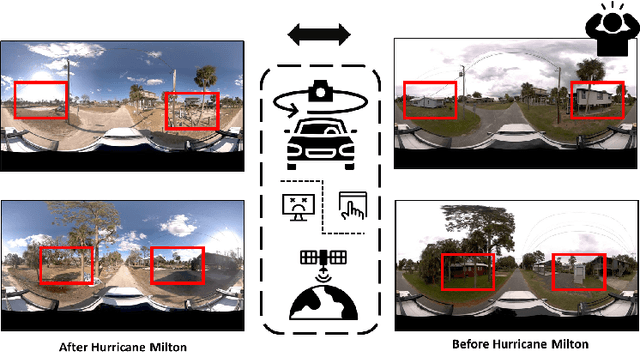
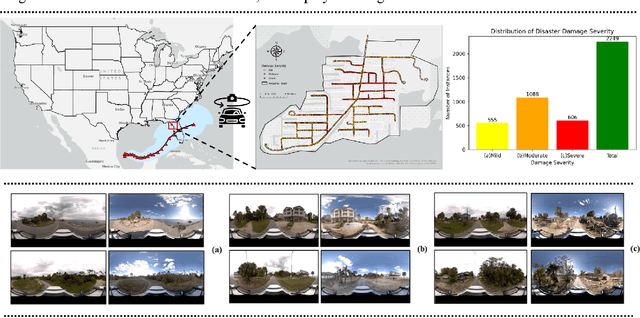
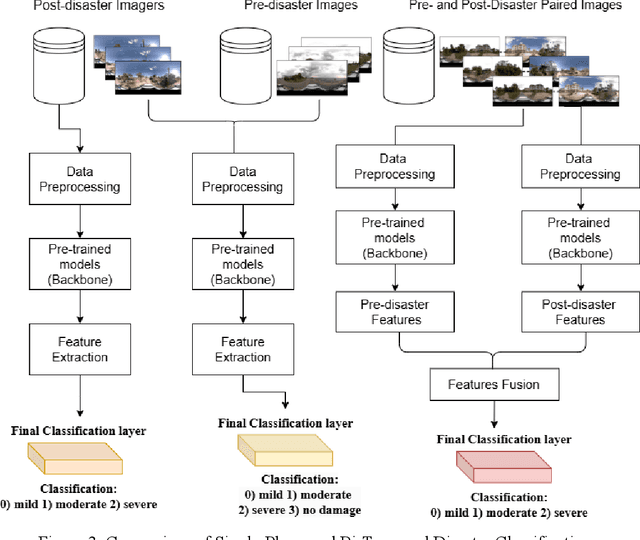

Abstract:Street-view images offer unique advantages for disaster damage estimation as they capture impacts from a visual perspective and provide detailed, on-the-ground insights. Despite several investigations attempting to analyze street-view images for damage estimation, they mainly focus on post-disaster images. The potential of time-series street-view images remains underexplored. Pre-disaster images provide valuable benchmarks for accurate damage estimations at building and street levels. These images could aid annotators in objectively labeling post-disaster impacts, improving the reliability of labeled data sets for model training, and potentially enhancing the model performance in damage evaluation. The goal of this study is to estimate hyperlocal, on-the-ground disaster damages using bi-temporal street-view images and advanced pre-trained vision models. Street-view images before and after 2024 Hurricane Milton in Horseshoe Beach, Florida, were collected for experiments. The objectives are: (1) to assess the performance gains of incorporating pre-disaster street-view images as a no-damage category in fine-tuning pre-trained models, including Swin Transformer and ConvNeXt, for damage level classification; (2) to design and evaluate a dual-channel algorithm that reads pair-wise pre- and post-disaster street-view images for hyperlocal damage assessment. The results indicate that incorporating pre-disaster street-view images and employing a dual-channel processing framework can significantly enhance damage assessment accuracy. The accuracy improves from 66.14% with the Swin Transformer baseline to 77.11% with the dual-channel Feature-Fusion ConvNeXt model. This research enables rapid, operational damage assessments at hyperlocal spatial resolutions, providing valuable insights to support effective decision-making in disaster management and resilience planning.
Toward General and Robust LLM-enhanced Text-attributed Graph Learning
Apr 03, 2025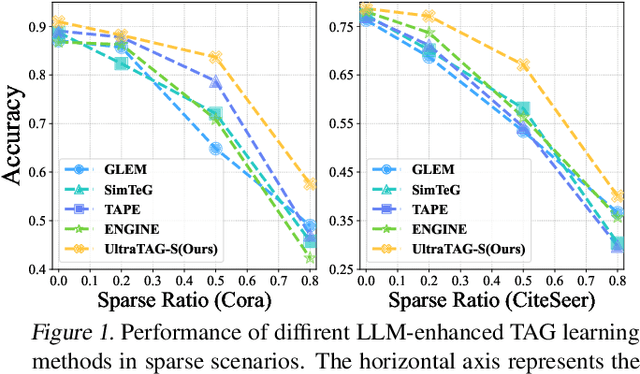

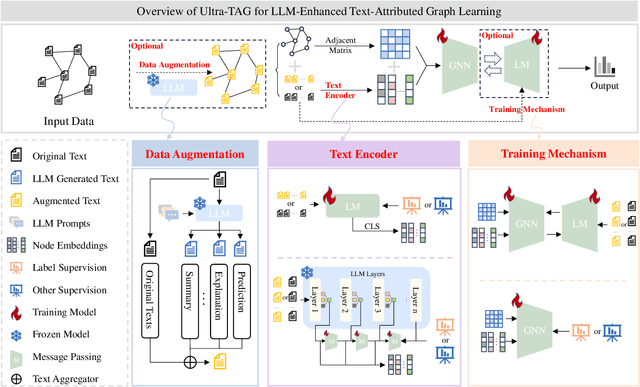

Abstract:Recent advancements in Large Language Models (LLMs) and the proliferation of Text-Attributed Graphs (TAGs) across various domains have positioned LLM-enhanced TAG learning as a critical research area. By utilizing rich graph descriptions, this paradigm leverages LLMs to generate high-quality embeddings, thereby enhancing the representational capacity of Graph Neural Networks (GNNs). However, the field faces significant challenges: (1) the absence of a unified framework to systematize the diverse optimization perspectives arising from the complex interactions between LLMs and GNNs, and (2) the lack of a robust method capable of handling real-world TAGs, which often suffer from texts and edge sparsity, leading to suboptimal performance. To address these challenges, we propose UltraTAG, a unified pipeline for LLM-enhanced TAG learning. UltraTAG provides a unified comprehensive and domain-adaptive framework that not only organizes existing methodologies but also paves the way for future advancements in the field. Building on this framework, we propose UltraTAG-S, a robust instantiation of UltraTAG designed to tackle the inherent sparsity issues in real-world TAGs. UltraTAG-S employs LLM-based text propagation and text augmentation to mitigate text sparsity, while leveraging LLM-augmented node selection techniques based on PageRank and edge reconfiguration strategies to address edge sparsity. Our extensive experiments demonstrate that UltraTAG-S significantly outperforms existing baselines, achieving improvements of 2.12\% and 17.47\% in ideal and sparse settings, respectively. Moreover, as the data sparsity ratio increases, the performance improvement of UltraTAG-S also rises, which underscores the effectiveness and robustness of UltraTAG-S.
Dance Like a Chicken: Low-Rank Stylization for Human Motion Diffusion
Mar 25, 2025Abstract:Text-to-motion generative models span a wide range of 3D human actions but struggle with nuanced stylistic attributes such as a "Chicken" style. Due to the scarcity of style-specific data, existing approaches pull the generative prior towards a reference style, which often results in out-of-distribution low quality generations. In this work, we introduce LoRA-MDM, a lightweight framework for motion stylization that generalizes to complex actions while maintaining editability. Our key insight is that adapting the generative prior to include the style, while preserving its overall distribution, is more effective than modifying each individual motion during generation. Building on this idea, LoRA-MDM learns to adapt the prior to include the reference style using only a few samples. The style can then be used in the context of different textual prompts for generation. The low-rank adaptation shifts the motion manifold in a semantically meaningful way, enabling realistic style infusion even for actions not present in the reference samples. Moreover, preserving the distribution structure enables advanced operations such as style blending and motion editing. We compare LoRA-MDM to state-of-the-art stylized motion generation methods and demonstrate a favorable balance between text fidelity and style consistency.
Toward building next-generation Geocoding systems: a systematic review
Mar 24, 2025Abstract:Geocoding systems are widely used in both scientific research for spatial analysis and everyday life through location-based services. The quality of geocoded data significantly impacts subsequent processes and applications, underscoring the need for next-generation systems. In response to this demand, this review first examines the evolving requirements for geocoding inputs and outputs across various scenarios these systems must address. It then provides a detailed analysis of how to construct such systems by breaking them down into key functional components and reviewing a broad spectrum of existing approaches, from traditional rule-based methods to advanced techniques in information retrieval, natural language processing, and large language models. Finally, we identify opportunities to improve next-generation geocoding systems in light of recent technological advances.
SceneMI: Motion In-betweening for Modeling Human-Scene Interactions
Mar 20, 2025
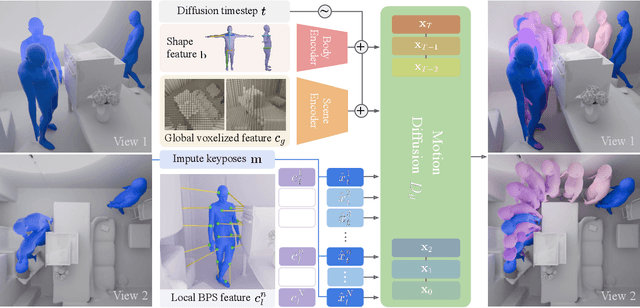


Abstract:Modeling human-scene interactions (HSI) is essential for understanding and simulating everyday human behaviors. Recent approaches utilizing generative modeling have made progress in this domain; however, they are limited in controllability and flexibility for real-world applications. To address these challenges, we propose reformulating the HSI modeling problem as Scene-aware Motion In-betweening -- a more tractable and practical task. We introduce SceneMI, a framework that supports several practical applications, including keyframe-guided character animation in 3D scenes and enhancing the motion quality of imperfect HSI data. SceneMI employs dual scene descriptors to comprehensively encode global and local scene context. Furthermore, our framework leverages the inherent denoising nature of diffusion models to generalize on noisy keyframes. Experimental results demonstrate SceneMI's effectiveness in scene-aware keyframe in-betweening and generalization to the real-world GIMO dataset, where motions and scenes are acquired by noisy IMU sensors and smartphones. We further showcase SceneMI's applicability in HSI reconstruction from monocular videos.
Snapmoji: Instant Generation of Animatable Dual-Stylized Avatars
Mar 15, 2025



Abstract:The increasing popularity of personalized avatar systems, such as Snapchat Bitmojis and Apple Memojis, highlights the growing demand for digital self-representation. Despite their widespread use, existing avatar platforms face significant limitations, including restricted expressivity due to predefined assets, tedious customization processes, or inefficient rendering requirements. Addressing these shortcomings, we introduce Snapmoji, an avatar generation system that instantly creates animatable, dual-stylized avatars from a selfie. We propose Gaussian Domain Adaptation (GDA), which is pre-trained on large-scale Gaussian models using 3D data from sources such as Objaverse and fine-tuned with 2D style transfer tasks, endowing it with a rich 3D prior. This enables Snapmoji to transform a selfie into a primary stylized avatar, like the Bitmoji style, and apply a secondary style, such as Plastic Toy or Alien, all while preserving the user's identity and the primary style's integrity. Our system is capable of producing 3D Gaussian avatars that support dynamic animation, including accurate facial expression transfer. Designed for efficiency, Snapmoji achieves selfie-to-avatar conversion in just 0.9 seconds and supports real-time interactions on mobile devices at 30 to 40 frames per second. Extensive testing confirms that Snapmoji outperforms existing methods in versatility and speed, making it a convenient tool for automatic avatar creation in various styles.
 Add to Chrome
Add to Chrome Add to Firefox
Add to Firefox Add to Edge
Add to Edge